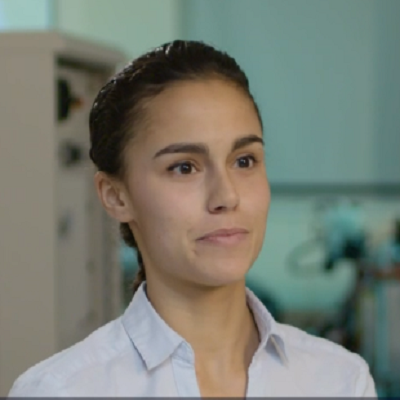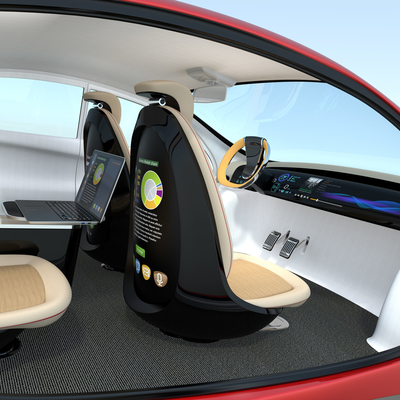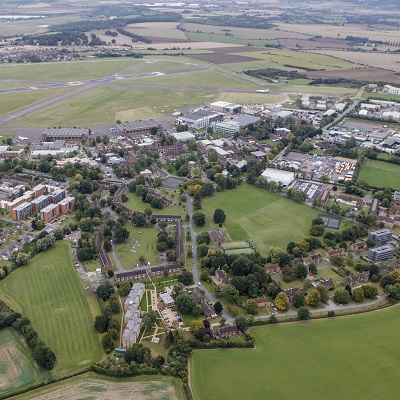Overview
- Start dateOctober
- DurationOne year full-time
- DeliveryTaught component (40%), Group project (20%), Individual research project (40%)
- QualificationMSc
- Study typeFull-time
- CampusCranfield campus
Who is it for?
This course is designed for students with a solid engineering, mathematics or applied science undergraduate degree, who want to strive for a skill set which combines electrical, mechanical, digital control systems and physical system modelling.
Why this course?
Cranfield's MSc in Automotive Mechatronics is unique in its combination of engineering and mechatronics and prepares students for careers in an ever-evolving automotive industry. Our reputation among organisations and senior players in the sector makes our graduates highly attractive and sought-after, and our strategic industry links means that as a student you will benefit from a high level of engagement with potential employers. The very design of the course is application- and industry-focussed, and as a student you will present your project work to a panel of automotive professionals, providing you a unique opportunity to build your professional network.
Cranfield University is uniquely located in close proximity to a concentration of automotive, motorsport and technology manufacturers, and during the course you will have the opportunity to take part in group visits organised in collaboration with our industry partners. We are also well located for visiting students from all over the world, and offer a range of library and support facilities to support your studies.
Informed by Industry
The Automotive Mechatronics MSc is directed by an Industrial Advisory Panel comprising senior engineers from the automotive sector. This maintains course relevance and ensures that graduates are equipped with the skills and knowledge required by leading employers. You will have the opportunity to meet this panel and present your individual research project to them at an annual event held in July. Panel members include:
Rod J Calvert OBE - (Chair), Consultant Automotive Management Consultant
Steve Miles, Director of Engineering TECNIQ
Peter Stoker, Director - Vehicle Engineering Millbrook Proving Ground Ltd
Stefan Strahnz, Chief Engineer - Business Process Transformation Mercedes-AMG Petronas Motorsport Formula One
Paul McCarthy, Chief Engineer - Performance, Controls & Integration JCB Power Systems
Steve Swift, Vehicle Engineering Director Polestar Automotive UK Ltd, Managing Director Leadfoot Limited, Co-Founder Balance Batteries
Doug Cross, Managing Director Leadfoot Limited, Co-Founder Balance Batteries
Steve Henson, Business Development Director Barclays UK Retail and Business Bank
David Hudson, Head of EV Strategy ePropelled Limited
Keith Benjamin, MD Jaguar Daimler Heritage Trust
Tobias Knichel, Managing Director Punch Flybrid Limited
William Hylton, Chief Engineer for Electrical Systems Polestar
Dr Charlie Wartnaby, Chief Engineer Applus IDIADA
Julie Stears, Chief Engineer, Engineering Quality Jaguar Landrover
Sally Leathers, Director of Software & EE Architecture McLaren Automotive
Course details
The Automotive Mechatronics MSc is made up of nine taught compulsory modules, which are generally delivered from October to March. During the first term, you will take modules in core automotive subjects, such as vehicle dynamics, design, vehicle performance, powertrain technology and vehicle structures.
In the second term, you will undertake a bespoke programme of study geared towards a greater understanding of physical systems, advanced control system design and rapid prototyping.
Course delivery
Taught component (40%), Group project (20%), Individual research project (40%)
Group project
You will undertake a substantial group project between October and March, which focuses on designing and optimising a particular vehicle system/assembly. This is designed to prepare you for the project-based working environment within the majority of the automotive industry.
Presentations are arranged to the Industrial Advisory Panel members (consisting of practising automotive engineers and managers), academic staff and fellow students, to market the product and demonstrate technical expertise. These presentations give you the opportunity to develop your presentation skills and effectively handle questions about complex issues in a professional manner.
The Automotive Mechatronics MSc Group Design Project presentations will be held on 8th March 2018. If you would like to attend please contact SASAutocourses@cranfield.ac.uk
Individual project
After having gained an excellent understanding of methods and applications, you will work full-time (May to September) on an individual research project. This research project will allow you to delve deeper into an area of specific interest, taking the theory from the taught modules and joining it with practical experience. A list of suggested topics is provided, and includes projects proposed by staff and industry sponsors, associated with current research projects.
It is clear that the modern design engineer cannot be divorced from the commercial world. In order to provide practice in this matter, a poster presentation and written report will be required from all students, and the research findings presented to the academic staff as well as the Industrial Advisory Panel members.
Modules
Keeping our courses up-to-date and current requires constant innovation and change. The modules we offer reflect the needs of business and industry and the research interests of our staff and, as a result, may change or be withdrawn due to research developments, legislation changes or for a variety of other reasons. Changes may also be designed to improve the student learning experience or to respond to feedback from students, external examiners, accreditation bodies and industrial advisory panels.
To give you a taster, we have listed the compulsory and elective (where applicable) modules which are currently affiliated with this course. All modules are indicative only, and may be subject to change for your year of entry.
Course modules
Compulsory modules
All the modules in the following list need to be taken as part of this course.
Automotive Mechatronics Induction
| Aim |
|
|---|---|
| Syllabus |
|
| Intended learning outcomes |
On successful completion of this module you will:
|
Vehicle Design, Propulsion and Performance
| Aim |
This module will provide deep understanding of vehicle propulsion options and driveline supporting students to analyse and predict vehicle performance. The interdependency of vehicle systems will be reviewed to critically evaluate the integration of different alternative powertrain options and be able to select appropriate solutions within legislation framework.
|
|---|---|
| Syllabus |
Basic vehicle characteristics: Vehicle concepts, centre of gravity position, static and dynamic loads and weight distributions, front, rear and all wheel drive. Adhesion coefficient and influencing factors. Traction, braking and resistance to motion. |
| Intended learning outcomes |
On successful completion of this module you should be able to: 1. Interpret and apply legislative requirements in generating vehicle concepts and designs. 2. Predict resistances to motion, determine powertrain system characteristics, calculate vehicle performance (max. speed, acceleration, gradient, fuel economy etc). 3. Revise vehicle concepts for propulsion driveline systems and components; optimise vehicle performance characteristics for the selected criteria / benchmarks. 4. Assess and critically evaluate vehicle systems and interdependency including vehicle design and ride quality |
Automotive Control and Simulation
| Aim |
• To equip you with the skills needed to understand, design and assess single-variable feedback control algorithms using classical control techniques for use in automotive systems. |
|---|---|
| Syllabus |
The module will provide knowledge in advanced control design tools and techniques and advance analytical methods in designing multivariable controllers with applications in the automotive engineering area. The theory of the multivariable controls will be introduced and then their use will be illustrated and developed by example applications. The theory and applications will be interleaved with selected associated topics (listed below) as appropriate through the module. o Representation of mechanical and electrical systems using differential equations. o Representation of linear systems and signals in the time domain, including convolution. o Use of Laplace transform methods for solving ordinary differential equations. o Transfer functions, poles and transmission zeros, and frequency responses.
The core syllabus is as follows: |
| Intended learning outcomes |
On successful completion of this module you should be able to: |
Vehicle Electrification and Hybridisation
| Aim |
The aim of this module is to empower students with the capability to analyse, synthesise and evaluate various technologies and integration challenges associated with Electric and Hybrid-Electric Vehicles. The module is structured to provide in-depth knowledge and expertise in the design and development of the main systems, components, and architectures of Electric and Hybrid-Electric Vehicles. The module includes case studies of commercially available Electric and Hybrid-Electric Vehicles, as well as a range of practical workshops. |
|---|---|
| Syllabus |
|
| Intended learning outcomes |
On successful completion of this module you should be able to: |
Vehicle Dynamics
| Aim |
• To introduce you to road vehicle ride and handling, from requirements to analytical modelling and practical viewpoints. • To link understanding of vehicle dynamics, ride and handling to the practical implications for suspension and steering system design. |
|---|---|
| Syllabus |
The module will provide knowledge in vehicle dynamics ride and handling from subjective and objective requirements to analytical methods in developing passive ride and handling models. |
| Intended learning outcomes |
On successful completion of this module you will be able to: 1. Compose vehicle dynamics models, from first principles, appraising the associated assumptions and implications to numerical simulations. 2. Evaluate vehicle ride and handling performance and the role of tyre and suspension characteristics. 3. Critically evaluate suspension and steering designs, including layout, geometry and materials and their influence on ride and handling. |
Mechatronics Modelling for Vehicle Systems
| Module Leader |
|
|---|---|
| Aim |
|
| Syllabus |
|
| Intended learning outcomes |
On successful completion of this module you should be able to:
|
Advanced Control and Optimisation
| Module Leader |
|
|---|---|
| Aim |
|
| Syllabus |
The module will provide knowledge in advanced control design tools and techniques and advance analytical methods in designing multivariable controllers with applications in the automotive engineering area. The theory of the multivariable controls will be introduced and then their use will be illustrated and developed by example applications. The theory and applications will be interleaved with selected associated topics (listed below) as appropriate through the module. The material will be addressed theoretically and practically: all lecture-based teaching will be supported by practical exercises using MATLAB and Simulink. Prior to the start of the module, you are expected to have reached a high standard of expertise in advanced classical control and the use of MATLAB and Simulink for control system design. As a guideline, you should have met the intended learning outcomes for the module ‘Automotive Control and Simulation’ before commencing this course. Students who have not taken this module should ensure they do sufficient pre-work prior to the module. Modelling multivariable systems:
Using time-based optimisation in multivariable control:
State estimator design:
Using norm-based optimisation to design robust controllers:
Reference conditioning using prefilters and two degree-of-freedom compensators (covered in outline only). Students will be provided with electronic copies of lecture slides, the lecturer’s handwritten notes and computer programs. Students are expected to complement this with their own notes. Recordings of the lectures will not be generally available for this module, though exceptions may be made for students who are unable to attend due to exceptional circumstances that are relevant, unexpected and external. |
| Intended learning outcomes |
On successful completion of this module you should be able to:
|
Embedded Vehicle Control Systems
| Module Leader |
|
|---|---|
| Aim |
Within the context of modern automotive control system, the aim of this module is for you to critically evaluate the different technologies and methods required for the efficient vehicle implementation, validation and verification of the automotive mechatronic system. |
| Syllabus |
Course content includes:
|
| Intended learning outcomes |
On successful completion of this module you should be able to:
|
Vehicle Control Applications
| Aim |
The aim of this module is to cover a range of applications of Control Theory and Artificial Intelligence techniques in different components of a modern vehicle including engines, electric motors, energy storage, steering, chassis, suspensions, advanced driver-assistance systems, etc. |
|---|---|
| Syllabus |
|
| Intended learning outcomes |
On successful completion of this module you should be able to:
|
Accreditation
The Automotive Mechatronics MSc is accredited by:
- The Institution of Mechanical Engineers (IMechE)
- Institution of Engineering and Technology (IET)
on behalf of the Engineering Council as meeting the requirements for further learning for registration as a Chartered Engineer (CEng).
I believe Cranfield was the best choice for me because automotive mechatronics is the future of the automotive industry. We work in different principles like electrified vehicles, autonomous vehicles and lots more that cover all automotive aspects. I have really enjoyed all of the modules, and am looking forward to writing my thesis – it’s really important that Cranfield provides a company-based thesis for our future.
Cranfield’s industry links are very useful because we have the ability to network staff in different companies, inside the automotive industry. Through this networking, we can use this knowledge to go further.
The industry links and the amount of external people that have come to the university to teach us for specific topics of the applied study. For example, we had someone come in for vehicle dynamics – just to cover tyre dynamics. Then we had other people just covering suspension, and people from specific fields which was very, very interesting – and how we apply it at laboratories in the assignments that we do.
I chose Automotive Mechatronics due to my interest in control/mechatronics and because the automotive field is an exciting industry to go into, especially with the ongoing transition to electric vehicles. The lecturers are all very knowledgeable and have a lot of experience in their fields, which shows in their lectures.
The course has provided me with an MSc in the kind of field I want to go into. I have learned many invaluable skills and tools which I’m sure I will use in my future career. I’d recommend the course to anyone who wants to pursue a career in control/mechatronic systems within the automotive or motorsport industry.
The automotive world always attracted me, and after I was granted an Erasmus scholarship to Cranfield, I took the chance to specialise in the field. In particular, the focus on mechatronics and up-to-date studies was key for my career and future development in the automotive sector.
I have been a development engineer in the Porsche engineering service since November 2017. I am in charge of simulation in advanced driver assistance systems (ADAS) projects, I supervise a bachelor thesis and enrolled in a project with international partners, which includes concept development and series production.
Your career
This course will take you on to an excellent career as a qualified engineer of the highest standard in the field of Automotive Mechatronics, capable of contributing significantly to the increased demand for experts in the field of vehicle electrification. The broad application of automotive mechatronics opens a wide range of career opportunities within the automotive sector.
Expected careers paths for graduates who have successfully completed the MSc in Automotive Mechatronics include further research or employment within internationally leading vehicle manufacturers and engineering consultancies and tier 1 suppliers to the automotive industry.
Job roles that students have gone into include:
- Senior Electrical & Electronic Design Engineer
- Research And Development Engineer
- Automotive Consultant Engineer
- System Validation Engineer
- R&D Engineer
- eMobility Senior Systems Engineer
- Senior Analysis Engineer
- Vehicle Simulation Engineer
- Control Systems Engineer
- Senior Test Engineer
- Automotive Cybersecurity Engineer
- Lead Functional Safety & Systems Engineering
- Automation and Systems Engineer
Companies that have recruited graduates of this course include:
- Airbus
- Aston Martin Lagonda Ltd
- Bosch Engineering GmbH
- Cosworth Ltd
- Mercedes AMG High Performance Powertrains Limited
- Nissan Motor Corporation
- Red Bull Powertrains
- Tata Technologies
- Volkswagen Commercial Vehicles
Cranfield’s Career Service is dedicated to helping you meet your career aspirations. You will have access to career coaching and advice, CV development, interview practice, access to hundreds of available jobs via our Symplicity platform and opportunities to meet recruiting employers at our careers fairs. Our strong reputation and links with potential employers provide you with outstanding opportunities to secure interesting jobs and develop successful careers. Support continues after graduation and as a Cranfield alumnus, you have free life-long access to a range of career resources to help you continue your education and enhance your career.
How to apply
Click on the ‘Apply now’ button below to start your online application.
See our Application guide for information on our application process and entry requirements.





















